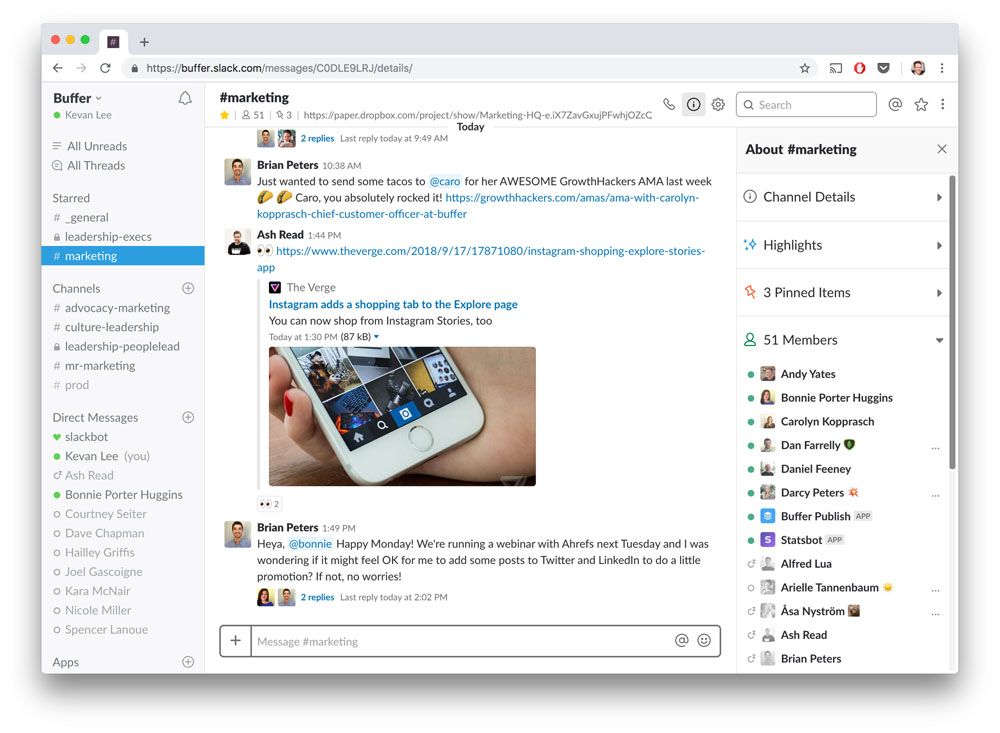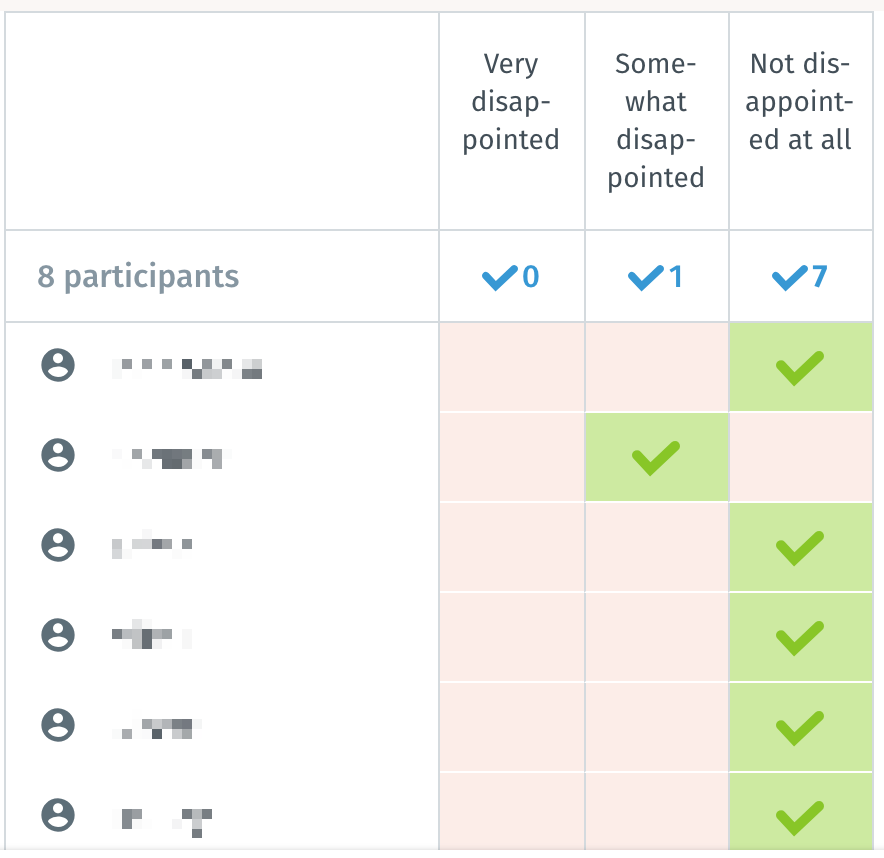Imagine a world without Slack ..
Weeping, mourning, and gnashing of teeth, right? Slack is a ubiquitous part of so many workplaces. The real-time messaging and communication app has become the go-to for so many remote workplaces, distributed teams, and offices. Buffer, included.
It’s also been a point of contention in our always-on, always-connected “alerts” culture.
Are we too reliant on Slack?
Many articles have made that claim. We’ve wondered ourselves at Buffer. Above and beyond, we are grateful for Slack’s influence on our remote work culture; we rely on it heavily, every day, to stay in touch and get work done.
So what would happen if we simply chose not to use Slack one day?
As always, we love experimenting at Buffer, so one of our teams explored this idea of turning off Slack. Keep reading to find out how we conducted the experiment and how it all went. And feel free to share any of your Slack stories in the comments.
If you’re interested in other Slack-centric stories, these may be worth a click:
- 17 Slack bots and apps for remote work teams
- The 10 Slack agreements at Buffer
- I turned off Slack for a week. Here’s what happened.
Our experiment: Slack-off Fridays ?
How we organized an area-wide “no Slack” day at Buffer

This summer, many of the different areas at Buffer — product, engineering, design, data, people, finance, advocacy, and marketing — experimented with different ways of working. Some teams worked half the day on Friday. Some teams used Friday for learning and personal development.
The marketing team adopted a “Focus Friday.”
Each Friday, we …
… turned off Slack for the day (Slack-off Fridays)
… focused on one or more of the following:
- Focus on a project (deep work)
- Focus on reflection (higher-level, strategic thinking)
- Focus on personal development (learn a new skill for your role)
- Focus on self-care (jump off early if it’s nice, take the day for yourself, etc.)
Teammates could choose any area of focus (or multiple areas) for their Friday and change it up week-to-week, whatever felt best and most useful that week.
(Interestingly enough, the vast majority of summer Fridays were spent in deep work, strategic thinking, or learning a new skill. When the team was surveyed each Monday, no one ever reported taking the Friday fully off.)
Practically-speaking, since this experiment was conducted only on the marketing team, it made sense to communicate what was happening with the wider Buffer company lest any teammate be looking for a marketer on Friday and find things oddly quiet. This was the message sent to the team:
I wanted to share a super quick note about a summer work experiment we’re trying on the marketing team. We’re going to treat the next few Fridays like Deep Work days, where we use the time for focused work, reflection, self-care, etc. Should be some good learnings!
One of the aspects of this experiment is that we’re aiming to be away from Slack on Fridays.
If you do need something on Fridays, you can absolutely use email or Paper to start conversations, and I’ll be “on call” if anything urgent needs marketing help – feel free to @here in the #marketing channel in Slack, and I’ll hop onto it.
Along with an email to the marketing team about the ground rules, that was all that was needed to kick off the experiment. For the next few months, every Thursday afternoon, we’d say our goodbyes in Slack and chat again — in real-time — on Monday.
A note about making this work with remote teams:
Since we have international teammates in various timezones, we also gave the option for Focus Friday / Slack-off Friday to be a Focus Monday / Slack-off Monday. For our Asia-Pacific teammates, Fridays overlap with many other people’s Thursdays, so we didn’t want to exclude those teammates from some valuable overlap time.
What happened when we turned off Slack for a day
1. We emailed each other more
When Slack was gaining popularity, people used to ask (Slack may have even asked it themselves), “Is Slack the new email?”
In our Slack-off experiment, we found that the inverse was true. Email was the new Slack.
Many of our conversations shifted to the many other tools at our disposal, all of which can filter straight to our inboxes. For instance:
- In Dropbox Paper, whenever you follow a Paper doc, you receive an update when that doc is changed in any way, shape, or form.
- In Trello, if you’re following a board or a card, you receive email updates every time a change is made.
So our team simply shifted our work convos from Slack to these other channels:
- We created Paper docs and @-mentioned teammates to invite them to collaborate
- We added comments to existing Paper docs
- We updated Trello cards and @-mentioned one another
And in the absence of a go-to tool, we would simply email one another to start a conversation or ask a question.
Note: You can check out our full list of remote work tools right here.
2. We questioned what needs to be synchronous
Our communication at Buffer is often labeled one of two ways: synchronous or asynchronous.
We communicate “async” in channels like email, Paper, Trello, and Github, where the conversation is not real-time. We communicate synchronously in Slack and on video calls, where the conversation happens right away.
(Slack is capable of being both sync and async, though we’ve noticed that there does seem to be some social expectation of a quick response on Slack regardless of how explicitly we state otherwise.)
Experimenting with Slack helped us re-tune our default setting.
Does this thing really need to be shared on Slack?
What is so urgent? Is there a better channel?
In most cases, it was not urgent, and there was a better channel.
Here’s a short list of examples where an async conversation proved just as fruitful as a synchronous one:
- Could someone read over this blog post I’ve written?
- Where can I find the Dropbox folder with our marketing playbooks?
- Can you check the budget spreadsheet and let me know any charges you don’t recognize?
3. Thursday became the new Friday
This was one of the unintended side effects of turning Slack off: We all sped up our internal clocks so that Thursday became our new Friday.
Since Friday turned into more of a heads-down work day, we felt the need to schedule calls and hold necessary conversations by the end of the day Thursday. Essentially, we had a four-day workweek in which to conduct our synchronous work.
This wasn’t ideal. But neither was it a huge blocker.
It just took some added planning and foresight to anticipate what lied ahead for you each week.
4. A casualty: “Check out this article I saw”
There was one thing we never quite found a place for: What do you do if you find a really cool article you want to share?
Yes, you could save it for Monday.
But (speaking personally) I’m neither good at remembering nor very adept at managing my browser tabs.
For those teammates who were able to stash their cool links, we were treated to a flurry on Monday morning. However, there were also several stories that were likely silenced because we didn’t have an adequate place to share in real-time.
(I personally found myself writing a list of things I wanted to Slack to my teammates on Mondays. I suppose the cool links could have been included here.)
5. We missed each other?
At the end of the experiment, after three summer months of not using Slack on Fridays, we answered a survey question:
How would you feel if we were to no longer do Slack-off Fridays (everyone stays off of Slack and we communicate asynchronously)?
- Very disappointed
- Somewhat disappointed
- Not disappointed at all
(This is the product/market fit survey question, in case it sounded familiar.)
The results were .. lopsided.

Seven out of our eight marketing teammates claimed they wouldn’t be disappointed at all if we moved on from the experiment and resumed our normal Slack hours.
And yes, part of this could be explained by a very contented team who does not disappoint easily, but another way of looking at is a bit more simple: We missed each other.
?
Slack alternatives for anyone interested in experiment
At Buffer, we’ve considered Slack alternatives for our team in the past — and have tried a tool or two. Here are the most common ones that have landed on our radar:
- Basecamp
- Google Chat / Hangouts (we use this whenever Slack is down)
- Skype
- Yammer
- Twist
Over to you
What is your relationship like with Slack?
Have you ever tried turning Slack off for awhile? What other fun experiments have you tried?
It’d be great to hear your thoughts in the comments. You can also get in touch with us on Twitter and share your story there.
P.S.
To stay connected with our latest workplace experiments about Slack, async work, and everything in between, you can subscribe to our free Open blog newsletter list.
Try Buffer for free
190,000+ creators, small businesses, and marketers use Buffer to grow their audiences every month.




